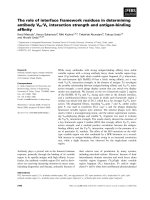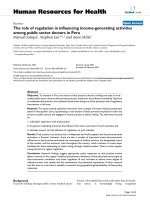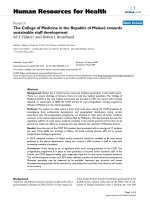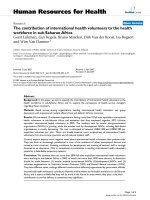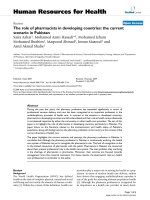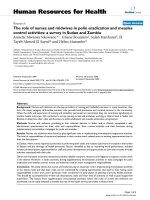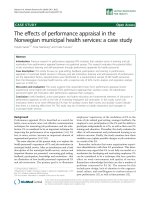Báo cáo sinh học: "The power of two experimental designs for detecting linkage between a marker locus and a locus affecting a quantitative character in a segregating population" pptx
Bạn đang xem bản rút gọn của tài liệu. Xem và tải ngay bản đầy đủ của tài liệu tại đây (699.05 KB, 13 trang )
Original
article
The
power
of
two
experimental
designs
for
detecting
linkage
between
a
marker
locus
and
a
locus
affecting
a
quantitative
character
in
a
segregating
population
ZW Luo
University
of
Edinbu!gh,
Institute
of
Cell
Animal
and
Population
Biology,
King’s
Buildings,
Edinburgh
EH
9
.!JT,
UK
(Received
14
November
1991;
accepted
9
February
1993)
Summary -
The
statistical
power
of
2
experimental
designs
(backcrossing
and
intercross-
ing)
for
detecting
linkage
between
a
marker
gene
and
a
quantitative
trait
locus
(QTL)
in
families
derived
from
a
segregating
population
is
investigated.
Formulae
which
relate
power
to
the
recombination
frequency
(r)
between
the
genes,
the
genetical
properties
of
the
quantitative
trait
controlled
by
the
QTL
and
the
design
parameters
are
developed.
The
reliability
of
some
simplifying
assumptions
was
confirmed
by
computer
simulations.
Application
of
these
formulae
has
shown
that
the
power
of
the
2
designs
with
population
size
of
1
000
was
<
20%
when
r
was
0.3
for
all
heritabilities
of
single
gene
considered,
few
large
families
are
better
than
many
small
families,
and
backcrossing
is
generally
more
efficient
than
intercrossing.
The
allele
frequencies
and
dominance
properties
of
the
QTLs
have
important
interactions
in
their
effects
on
power.
statistical
power
/
marker -
QTL
linkage
/
backcross
/
intercross
Résumé -
Puissance
de
2
plans
d’expérience
pour
détecter
une
liaison
génétique
entre
un
locus
marqueur
et
un
locus
influençant
un
caractère
quantitatif
dans
une
popu-
lation
en
ségrégation.
Cet
article
étudie
la
puissance
statistique
de
2
plans
d’expérience
(rétrocroisement
et
intercroisement
de
FI)
pour
détecter
une
liaison
génétique
entre
un
gène
marqueur
et
un
locus
de
caractère
quantitatif
(QTL)
dans
des
familles
dérivées
d’une
population
en
ségrégation.
Des
formules
sont
établies
pour
exprimer la
puissance
en
fonc-
tion
du
taux
de
recombinaison
(r)
entre
les
gènes,
des
propriétés
génétiques
du
caractère
quantitatif
contrôlé
par
le
QTL
et
des
paramètres
du
plan
d’expérience.
La
fiabilité
de
’
Correspondence
and
reprints:
Institute
of
Animal
Physiology
and
Genetics
Research,
Roslin,
Edinburgh
EH25
9
PS,
UK.
quelques
hypothèses
simplificatrices
a
été
confirmée
par
des
simulations
sur
ordinateur.
L’application
de
ces
formules
montre
que
la
puissance
des
2 plans,
pour
une
taille
de
population
de
1 000,
est
inférieure
à
20%
quand
r
est
supérieur
à
0,3
pour
toutes
les
héritabilités
du
gène
considéré,
qu’un
nombre
limité
de
familles
de
grande
taille
vaut
mieux
qu’un
grand
nombre
de
petites
familles,
et
que
le
rétrocroisement
est
généralement
plus
ef-
ficace
que
l’intercroisement.
Les
fréquences
alléliques
et
la
dominance
au
locus
du
caractère
quantitatif
interagissent
fortement
dans
leurs
effets
sur
la
puissance.
puissance
statistique
/
liaison
marqueur-QTL
/
rétrocroisement
/
intercroisement
INTRODUCTION
With
the
rapid
development
of
molecular
techniques
in
the
last
decade,
their
application
to
the
investigation
of
the
genetical
basis
of
quantitative
characters
has
become
a
subject
of
considerable
activity
(Botstein
et
al,
1980;
Beckmann
and
Soller,
1986;
Lander
and
Botstein,
1989).
The
central
idea of
these
new
investigations
was
to
use
the
newly-discovered
molecular
markers
(for
example,
RFLPs)
at
defined
map
positions
for
tracing
linked
quantitative
trait
loci
((aTLs).
Methodologically,
this
can
be
accomplished
by
detecting
linkage
between
a
genetic
marker(s)
and
a
QTL(s)
through
various
appropriate
experimental
designs
(Breese
and
Mather,
1957,
1960;
Thoday,
1961;
Jayakar,
1970;
Hill,
1975;
Weller,
1986;
Luo,
1989;
Luo
and
Kearsey,
1989;
Lander
and
Botstein,
1989).
Hill
(1975)
demonstrated
the
use
of
analysis
of
variance
for
detecting
linkage
between
a
marker
gene
and
a
QTL
by
means
of
a
nested
backcrossing
or
intercross-
ing
experiment
and
attempted
to
work
out
the
power
of
these
designs.
However,
because
of
the
varying
sizes
of
each
of
the
nested
groups,
the
numerator
of
the
final
test
statistic
used
in
the
analysis
of
variance
to
detect
the
marker-QTL
linkage
cannot
be
expressed
as
a
constant
times
a
random x2
variable.
Therefore,
she
was
unable
to
work
out
analytical
expression
for
the
power
of
the
experimental
designs.
Soller
et
al
(1976, 1978)
suggested
excluding
the
offspring
with
heterozygous
marker
genotypes
in
the
power
analyses
of
the
intercross
design
in
order
to
increase
the
power
of
the
designs.
This
has
also
avoided
the
complexity
caused
by
the
unequal
sample
sizes
among
the
different
marker
genotypes
and
allowed
use
of
the
normal
procedure
of
hierarchical
analysis
of
variance
so
as
to
set
up
an
F-distributed
test
statistic.
Obviously,
this
results
in
the
loss
of
useful
information
and
artificially
inflates
the
expected
variance
between
offspring
marker
classes.
The
present
paper
will
focus
on
exploring
a
statistical
approach
to
work
out
the
experimental
power
of
the
designs
suggested
by
Jayakar
(1970)
and
Hill
(1975)
and
relate
the
power
directly
to
genetic
parameters
of
the
marker
gene
and
the
QTL
and
the
relevant
design
parameters.
This
will
allow
factors
affecting
the
power
to
be
investigated
comprehensively.
THEORY
Basic
assumptions
and
experimental
design
The
method
involves
analysing
progeny
from
natural
or
controlled
matings
in
a
population.
Consider
2
autosomal
loci,
one
affects
a
quantitative
character
(QTL)
while
the
other
is
a
codominant
marker.
The
2
loci
are
linked
with
a
recombination
fraction
of
r
(r’
=
1
-
r).
Let
the
frequency
of
allele
QI
at
the
QTL
be
denoted
p
(p
=
1 -
q)
and
the
phenotypic
distributions
of
the
3
genotypes
at
the
QTL,
ie
Q1Q1
, Q
1Q2
and
Q
2Q2
are
assumed
to
be
N(IL
+a,
(J’2
),
N(M+d,
(J’
2)
and
N(p-a,
(J’
2)
respectively,
where
a
and d
represent
the
additive
and
dominant
effect
at
the
QTL
(Falconer,
1989).
With
just
one
QTL,
02
will
be
the
environmental
variance
alone,
but
with
other
unlinked
QTLs,
it
will
also
include
genetic
variance
at
these
loci.
The
phenotypes
of
the
3
marker
genotypes,
viz
M, M
l
, M, M
2
and
M2M2
are
distinguishable,
ie
the
marker
locus
is
codominant
and
we
assume
that
the
QTL
and
the
marker
gene
are
in
linkage
equilibrium
in
the
population.
One
can
score
the
progeny
of
these
families
where
parents
are
M1M1
x
M1M2
or
MIM2
x
MlM2
(ie
backcrossing
or
intercrossing)
and
record
the
quantitative
phenotype
and
marker
genotype.
If,
for
example,
we
consider
an
experiment
consisting
of
s
sibships,
within
each
of
which
there
are
m
marker
classes
(m
=
2
and
3
for
backcrossing
and
intercrossing
designs,
respectively).
Let
nZ!
represent
the
number
of
sibs
within the
jth
marker
class
within
the
ith
sibship,
then
the
variation
for
the
quantitative
trait
can
be
partitioned
into
that
between
and
within
sibships,
while
that
of
within
sibships
can
be
further
partitioned
into
variation
within
and
between
marker
genotypes.
For
such
unbalanced
2-way
nested
classification
data,
variance
components
have
been
worked
out
by
Searle
(1971,
p
475-477).
If
it
is
further
assumed
that
each
sibship
has
a
constant
size
of
n
then
the
total
experimental
size
is
s
x
n
and
analysis
of
variance
for
both
backcrossing
and
intercrossing
designs
is
illustrated
in
table
I,
in
which:
following
Searle
(1961)
and
Snedecor
and
Cochran
(1968,
p
189-191).
Statistical
model
In
the
analysis
of
variance
described
in
table
I,
the
linear
model
for
phenotypic
record
of
the
quantitative
trait
measured
on
the
kth
sib
(k
=
i, 2, ,
n2!)
with
the
jth
marker
genotype
(j
=
1,2, , m)
within
the
ith
sibship
(i
=
1,2, , s)
can
be
written
as:
where
ii
is
an
overall
population
mean
while
Q
i, /3
ij
and
ez!!
are
contributions
from
the
sibship,
from
the
marker
genotype
within
sibship
and
residual
error
respectively.
They
are
assumed
to
be
independently
and
normally
distributed
with
zero
means
and
variances
o, 2,
o
l2
and
o,2
respectively.
The
frequency
distribution
of
the
QTL
genotypes,
the
expected
means
and
variances
of
the
progenies
within
the
ith
marker
genotypes
and
within
all
possible
sibships
were
obtained
by
IIill
(1975),
and
these
were
carefully
rederived
by
Luo
(1989).
It
was
found
that
the
expected
variance
between
marker
genotypes
within
sibships
(a2)
is:
and
the
expected
variance
within
marker
genotypes
within
sibships
(0
&dquo;)
is:
for
the
intercross
design;
while
the
corresponding
variances
for
the
backcross
design
are:
It
is
easily
seen
from
equations
[3.lt
and
[4.1]
that
the
expected
variance
between
marker
genotypes
within
sibship
(u
M(I)
or
o,2 m(
B)
)
for
either
the
intercross
or
backcross
design
will
be
statistically
zero
if
the
marker
gene
is
not
linked
with
the
QTL,
ie
r
=
0.5.
The
expected
variance
could
also
be
zero
if
one
of
alleles
at
the
QTL
is
fixed,
ie
p
=
0
or
1,
but
these
situations
are
trivial.
As
pointed
out
by
Jayakar
(1970),
under
the
null
hypothesis
Ho :
r =
0.5,
the
following
ratio
of
mean
squares:
is
distributed
as
a
central
F-variable
with
expected
value
of
1.
However,
the
ratio
will
be
a
noncentral
F-variable
when
r
is
less
than
0.5.
The
denominator
of
the
right
side
of
[5]
is
distributed
as
12
However,
when
the
cell
sizes
(nij
)
are
not
constant
over
the
marker
genotypes,
the
numerator
of
the
F-ratio,
cannot
be
expressed
as
a
linear
combination
of
chi-square
variables.
Therefore
it is
difhcult
to
determine
the
power
of
the
test
directly,
contrary
to
a
traditional
F-test
when
the
null
hypothesis
is
false.
However,
under
the
assumption
of
constant
size
of
sibships,
the
following
approximation:
can
be
incorporated
into
equation
[1]
for
the
intercrossing
design
and
[1]
can
thus
be
rewritten
as:
-
1
!,
Similarly,
the
following
approximation
holds
between
sizes
of
2
subsibships
for
the
backcrossing
design:
which
directly
results
in:
1
therefore,
the
expectation
of
MS,,,
in
equation
[5]
can
be
approximated
by
a
general
form:
where
aM
and
<7
{y
are
respectively
defined
by
!3.1!
and
[3.2]
for
intercrossing
design
or
by
[4.1]
and
[4.2]
for
backcrossing
design.
If
the
marker
genotypes
[,3ij]
in
model
[2]
are
considered
to
be
fixed
effects
in
analysis
of
variance
described
in
table
I,
then
the
statistic
for
testing
the
presence
of
linkage
between
the
marker
gene
and
QTL
is:
where
F
is
a
noncentral F-variable
with
degrees
of
freedom
described
in
table
I
and
the
noncentrality
parameter:
whose
definition
is
the
same
as
that
in
Kendall
et
al
(1983,
p
37)
and
in
Johnson
and
Kotz
(1970,
p
191).
By
definition,
the
power
function
of
the
2
designs
for
detecting
the
linkage
can
be
written
in
the
following
general
form:
where
Fv,,v2;
6 represents
a
noncentral
F-variable
with
degrees
of freedom
vi
and
v2
and
noncentral
parameter
6 while
Fa;Vl;V2
stands
for
the
upper
a
point
of
a
central
F-variable
with
degrees
of
freedom
VI
and
v2.
Power
calculation
So
far,
the
power
for
detecting
the
linkage
by
use
of
these
designs
has
been
shown
to
be
a
function
of
the
recombination
fraction
(r)
and
the
basic
genetic
parameters
at
the
QTL,
mamely
the
allelic
frequency
p
(q
=
1 -p),
the
additive
and
dominant
effects
at
the
QTL
(a
and
d),
the
residual
variance
(or 2)
as
well
as
the
experimental
design
parameters
s
(ie
the
number
of sibships)
and
n
(ie
the
size
of
the
sibships).
For
a
given
broad
heritability
(h’)
and
dominance
ratio
(f
= !)
at
the
QTL,
the
b
a
genetic
variance
associated
with
the
QTL
in
an
F2
population
is:
For
convenience,
let
the
phenotypic
variance
of
the
quantitative
trait
in
the
F2
population
be
100,
the
additive
and
dominant
effect
(a
and
d)
can
be
solved
as:
and
the
additive
and
dominance
effects
at
the
QTL
are
obtained
from:
Once
the
design
parameters
(s
and
n)
and
the
genetic
parameters
at
the
QLT
(p,
f
and
h’)
are
given
together
with
the
recombination
frequency
between
the
marker
and
QTL
(r),
the
value
of
the
noncentral
F-variable
can
be
calculated
by
using
equation
(9!.
For
a
given
significance
level
a
of
the
test,
the
power
of
detecting
the
linkage
can
thus
be
worked
out
through
equation
[11]
directly
by
using
the
relevant
statistical
tables
such
as
that
by
Tang
(1938)
or
Tiku
(1967).
Although
these
tables
are
available
to
provide
the
power
of
an
F-test
they
are
restricted
to
a
limited
number
of
degrees
of
freedom
and
to
a
limited
range
of
values
of
the
noncentral
parameter.
However,
several
procedures
are
available
to
approximate
the
power
of
the
F-test
(Patnaik,
1949;
Laubscher,
1960;
Tiku,
1965,
1967).
For
its
higher
accuracy,
Tiku’s
3-moment
common
approximation
by
using
Laguerre
series
was
programmed
in
Mathematica
(Wolfram,
1991)
to
evaluate
the
experimental
power
in
the
present
paper.
Power
evaluation
from
simulations
Since
approximations
[6.2]
and
[7.2]
were
made
in
deriving
the
power
function,
the
reliability
of
these
approximations
was
checked
by
comparing
the
theoretical
predic-
tion
of
the
power
to
the
powers
which
were
calculated
from
simulation
experiments.
A
Fortran-77
computer
programme
was
designed
for:
i)
simulating
the
inheritance
of
the
marker-QTL
linkage
in
the
2
nested
experiments
as
described
above
for
any
combinations
of
experimental
design
and
genetic
parameters
(Luo,
1989);
ii)
com-
puting
F-value
from
analysis
of
variance
using
the
simulation
data
following
the
algorithm
described
by
Searle
(1971);
and
iii)
calculating
the
frequency
of
signif-
icant
F-values
in
replicated
simulation
trials
as
in
Carbonell
et
al,
(1992),
which
gives
the
empirical
power.
RESULTS
Although
the
power
of
the
2
designs
can
be
easily
investigated
at
any
combinations
of
experimental
design
and
genetic
parameters,
a
total
experimental
size
of
1
000
was
only
considered
here.
The
powers
of
the
2
designs
were
evaluated
by
both
theoretical
prediction
and
computer
simulation
for
all
possible
combinations
of
2
design
structures
(10
(sibships)
x
100
(sibs)
and
20
x
50),
heritability
h2
=
0.01,0.05
and
0.10,
allelic
frequency
p
=
0.25,0.5
and
0.75,
dominance
ratio
f
=
0.0,0.5
and
1.0
as
well
as
recombination
frequency
between
the
marker
gene
and
QTL
r
=
0.0,0.1
and
0.3.
The
powers
were
evaluated
at
a
significant
level
(a)
equal
to
0.05.
For
simplicity,
only
part
of
the
results
were
listed
in
table
II
for
demonstrating
an
agreement
between
powers
evaluated
from
theoretical
prediction
and
simulation
based
on
500
replicates
(in
parentheses).
The
powers
of
the
2
designs
were
also
computed
analytically
for
the
experimental
size
of
1 000
but
realistically
smaller
size
of
sibsips
and
were
tabulated
in
table
III.
It
could
be
interesting
to
compare
the
present
power
predictor
to
that
of
Soller
and
Genizi
(1978).
Table
III
in
Soller
and
Genizi
(1978)
listed
the
number
of
sibships
and
the
total
experimental
sizes
required
for
achieving
a
power
of
90%
when
the
allelic
frequency
(p),
dominance
ratio
( f )
and
contrast
at
the
QTL
were
0.5,
0.0
and
0.01
(equivalent
to
1%
heritability
in
the
present
study)
respectively,
and
the
recombination
frequency
between
the
marker
and
QTL
was
zero.
The
powers
with
these
population
structures
and
the
same
genetic
parameters
were
evaluated
by
use
of
the
present
method.
The
difference
of
the
evaluated
powers
to
90%
has
been
summarised
in
table
IV.
Effects
of
recombination
frequency
between
the
marker
and
QTL
(r),
allelic
frequency
(p)
and dominance
ratio
( f )
at
the
QTL
on
the
power
of
both
backcrossing
and
intercrossing
designs
have
been
illustrated
in
figure
1
for
a
given
heritability
of
0.1.
DISCUSSION
Derivations
in
the
present
paper
have
shown
that
the
power
of
the
2
kinds
of
designs
for
detecting
linkage
between
a
marker
gene
and
a
QTL
can
be
expressed
as
function
of
design
parameters
and
parameters
describing
genetic
properties
of
the
marker
and
QTL.
The
powers
from
theoretical
evaluation
agree
very
well
with
those
from
stochastic
simulation
under
consideration
of
a
wide
range
of
situations
(table
II),
suggesting
reliability
of
the
theoretical
analysis.
Recombination
frequency
between
the
marker
and
QTL
displayed
a
pronounced
effect
on
the
power
when h
2
>
0.05
(tables
II,
III).
In
this
case,
both
designs
70%
of
their
power
with
an
increase
of
r
from
0.1
to
0.3.
Moreover,
the
linkage
would
be
unlikely
to
be
detected
(power
<
20%)
when
the
QTL
would
be
linked
to
the
marker
with
a
recombination
frequency >
0.3
when
h2
6
0.1.
It
has
been
pointed
out
by
Risch
(1991)
and
Collins
and
Morton
(1991)
that
power
is
dramatically
reduced
when
the
recombination
frequency
is
>
0.3.
Recently,
Luo
and
Woolliams
(1992)
studied
the
effect
of
recombination
frequency
between
marker
and
QTL
on
accuracy
of
estimation
of
genetic
parameters
of
the
QTL
with
heritability
of
0.1
and
found
that
maximum
likelihood
estimates
of
these
parameters
is
usually
biased
once
the
recombination
frequency
reaches
0.3.
The
power
of
both
designs
increased
with
increasing
dominance
ratio
at
low
allelic
frequency
(p
=
0.25)
(fig
la),
but
decreased
with
increasing
dominance
ratio
at
high
allelic
frequency
(p
=
0.75)
(fig
lc).
However,
there
was
little
effect
of
dominance
on
the
power
of
backcrossing
at
the
allelic
frequency
of
0.5.
At
the
same
allelic
frequency
the
power
of
intercrossing
still
increased
with
increasing
dominance
ratio
(fig
1b).
There
was
no
evidence
of
effect
of
allelic
frequency
on
the
power
of
both
designs
when
gene
effect
at
the
QTL
was
purely
additive
( f
=
0.0)
(fig
1d).
However,
the
power
decreased
with
increasing
allelic
frequency
when
the
allele
displayed
dominance
(fig
le,
f).
Soller
and
Genizi
(1978)
published
the
first
comprehensive
theoretical
study
of
the
same
designs
as
addressed
in
the
present
paper
but
through
investigating
sig-
nificance
of
contrast
between
means
of
marker
genotypes
of
interest
in
quantitative
trait.
They
concluded
that
the
effects
of
gene
frequency
and
dominance
level
would
be
important
when
the
number
of
families
was
small.
Because
when
the
number
of
families
is
small,
the
probability
that
the
contrast
in
each
of
the
families
be
zero
is
so
large
that
the
power
requirement
will
not
be
met
for
any
size
of
family.
They
suggested
that
the
probability
of
zero
contrast
would
be
0.90
for
backcrosses
and
0.94
for
intercrosses
when
a =
d
and
2pq
=
0.3.
Therefore,
at
least
22
and
34
fam-
ilies
for
the
2
designs
respectively
must
be
sampled
in
order
that
on
average
non
zero
contrasts
can
be
expected
in
2
of
these
families.
However,
if
the
power
of
these
designs
is
calculated
in
the
way
developed
in
the
present
paper,
loss
in
the
power
due
to
probability
of
sampling
families
with
zero
contrast
can
be
avoided,
since
it
is
likely
that
those
families
with
zero
contrast
will
nevertheless
contribute
to
sig-
nificance
of
the
variance
between
marker
types
within
families.
In
fact,
in
the
case
of
h2
=
0.01,
f
=
1.0, 2pq
=
0.3
and
experimental
size
of
5 000
(10
x
500),
a
power
of
0.76
(0.70)
for
the
backcrossing design
or
0.64
(0.62)
for
the
intercrossing
design
was
obtained
from
the
theoretical
prediction
(simulation)
in
the
present
study.
Comparison
in
table
IV
was
made
between
the
present
power
predictor
and
that
in
Soller
and
Genizi
(1978).
It
can
be
seen
that
the
powers
of
the
backcrossing
designs
were
slightly
higher
in
the
present
paper
than
in
Soller
and
Genizi
(1978).
While
the
present
method
yielded
higher
power
of
the
intercrossing
designs
with
small
number
of sibships
and
large
sibship
size
than
in
Soller
and
Genizi
(1978),
in
which
offspring
class
with
heterozygous
genotype
at
the
marker
locus
was
excluded.
However,
with
large
number
of
sibships
and
small
sibship
size,
the
power
of
the
intercrossing
designs
was
lower
in
the
present
paper
than
in
Soller
and
Genizi
(1978).
Several
researchers
(Hill,
1975;
Soller
and
Genizi,
1978)
have
found
that
for
a
given
total
experimental
size,
design
with
fewer
sibships
but
larger
sibship
size
was more
powerful
than
that
with
more
sibships
but
smaller
sibship
size.
This
was
confirmed
by
the
present
study.
Moreover,
it
was
found
that
decline
in
power
due
to
smaller
sibship
size
was
more
severe
for
intercrossing
design
than
for
backcrossing
design
(tables
II,
III).
The
effect
of
the
population
structure
on
the
power
is
parallel
to
its
effect
on
degrees
of
freedom
of
the
residual
expected
mean
square
(table
I).
For
most
animal
species,
realistic
full
sibship
size
is
very
small,
eg
5
to
20,
but
half-sibship
size
might
be
very
large.
Weller
et
al
(1990)
investigated
daughter
and
granddaughter
designs
and
their
powers
for
detecting
the
marker
and
QTL
linkage
in
dairy
cattle
populations
in
which
one
sire
might
have
several
hundred
daughters
or
granddaughters
if
breeding
was
by
AI.
By
organising
experiment
of
such
animal
species
into
half-sibship
population
structure,
one
might
expect
more
power
since
the
residual
expected
mean
square
would
have
more
degrees
of
freedom.
Comparison
of
power
of
the
2
designs
revealed
that
backcrossing
was
generally
more
powerful
than
intercrossing.
This
agrees
with
the
conclusion
of
Soller
and
Genizi
(1978).
The
present
studies
have
not
directly
provided
the
total
experimental
size
required
for
a
given
power
under
a
particular
genetic
and
design
situation.
The
theoretical
calculation
in
the
present
paper
can,
however,
be
easily
used
in
the
procedure
suggested
by
Fox
(1956)
so
as
to
obtain
the
size
of
experiment
for
a
given
power
in
a
specific
situation.
ACKNOWLEDGMENTS
I
thank
MJ
Kearsey,
R
Thompson
and
C
Haley
for
their
useful
comments
and
helpful
discussions
in
this
paper
and
3
anonymous
reviewers
for
their
many
constructive
suggestions
and
criticism.
REFERENCES
Beckmann
JS,
Soller
M
(1986)
Restriction
fragment
length
polymorphisms
and
genetic
improvement
of
agricultural
species.
Euphytica
35,
111-124
Botstein
D,
White
RL,
Skolink
M,
Davies
RW
(1980)
Construction
of
a
genetic
linkage
map
using
restriction
fragment
length
polymorphisms.
Am
J
Hum
Genet
27, 314-331
Breese
EL,
Mather
K
(1957)
The
organisation
of
polygenic
activity
within
a
chromosome
in
Drosophila:
I.
Hair
characters.
Heredity
11,
373-395
Breese
EL,
Mather
K
(1960)
The
organisation
of
polygenic
activity
within
a
chromosome
in
Drosophila:
II.
Viability.
Heredity
14,
375-399
Carbonell
EA,
Gerig
TM,
Balansard
E,
Asins
MJ
(1992)
Interval
mapping
in
the
analysis
of
nonadditive
quantitative
trait
loci.
Biometrics
48,
305-315
Collins
A,
Morton
NE
(1991)
Significance
of
maximal
lods.
Ann
Hum
Genet
55,
39-41
Falconer
DS
(1989)
Introduction
to
Quantitative
Genetics.
Longman
Scientific
and
Technical,
3rd
edn
Fox
M
(1956)
Charts
of
the
power
of
the
F-test.
Ann
Math
Stat
27,
484-497
Hill
AP
(1975)
Quantitative
linkage:
a
statistical
procedure
for
its
detection
and
estimation.
Ann
Hum
Genet
(Lond)
38,
439-449
Jayakar
SD
(1970)
On
the
detection
and
estimation
of
linkage
between
a
locus
influencing
a
quantitative
character
and
a
marker
locus.
Biometrics
26,
451-464
Jonhson
NL,
Kotz
S
(1970)
Distributions
in
Statistics:
Continuous
Univariate
Distributions.
Houghton
Miffin,
Boston,
MA
Kendall
MG,
Stuart
A,
Ord
JK
(1983)
The
Advanced
Theory
of
Stati.stics,
Vol
3:
Design
and
Analysis,
and
Times-Series.
Charles
Griffin
Ltd,
4th
edn
Lander
ES,
Botstein
D
(1989)
Mapping
Mendelian
factors
underlying
quantitative
traits
using
RFLP
linkage
maps.
Genetics
121,
185-199
Laubscher
NH
(1960)
Normalizing
the
noncentral
t
and
F
distributions.
Ann
Math
Stat
31,
1105-1112
Luo
ZW
(1989)
Polygene
location
and
selection
for
heterotic
traits
in
Drosophila
melanogaster.
Ph
D
thesis,
Univ
Birmingham,
UK
Luo
ZW,
Kearsey
MJ
(1989)
Maximum
likelihood
estimation
of
linkage
between
a
marker
gene
and
a
quantitative
locus.
Heredity
63, 401-408
Luo
ZW,
Woolliams
J
(1992)
Estimation
of
genetic
parameters
by
using
linkage
between
a
locus
underlying
a
quantitative
trait
and
a
marker
locus.
Heredity
70,
245-253
Patnaitk
PB
(1949)
The
noncentral
X 2_
and
F-distributions
and
their
applications.
Biometrika
36,
202-232
Risch
N
(1991)
A
note
on
multiple
testing
procedures
in
linkage
analysis.
Am
J
Hum
Genet
48,
1058-1064
Searle
SR
(1961)
Variance
components
in
the
unbalanced
2-way
nested
classifica-
tion.
Ann
Math
Stat
32,
1161-1166
Searle
SR
(1971)
Linear
Models.
John
Wiley
and
Sons,
London
Snedecor
GW,
Cochran
WG
(1968)
Statistical
Methods.
The
Iowa
State
Univ
Press,
Ames,
IA
Soller
M,
Brody
T
(1976)
On
the
power
of
experimental
designs
for
the
detection
of
linkage
between
marker
loci
and
quantitative
loci
in
crosses
between
inbred
lines.
Theor
Appl
Genet
47,
35-39
Soller
M,
Genizi
A
(1978)
The
efficiency
of
experimental
designs
for
the
detection
of
linkage
between
a
marker
locus
and
a
locus
affecting
a
quantitative
trait
in
segregating
populations.
Biometrics
34,
47-55
Tang
CP
(1938)
The
power
function
of
the
analysis
of
variance
test
with
tables
and
illustrations
of
their
use.
Stat
Res
Mem
2,
126-149
Thoday
ML
(1961)
Location
of
polygenes.
Nature
(Lond)
vol
191,
368-370
Tiku
ML
(1965)
Laguerre
series
forms
of
noncentral
X
2_
and
F-distributions.
Biometrika
52,
415-427
Tiku
ML
(1967)
Tables
of
the
power
of
the
F-test.
J
Am
Stat
Assoc
62,
525-539
Weller
JI
(1986)
Maximum
likelihood
techniques
for
the
mapping
and
analysis
of
quantitative
trait
loci
with
the
aid
of
genetic
markers.
Biometrics
42,
627-640
Weller
JI,
Kasi
Y,
Soller
M
(1990)
Power
of
daughter
and
granddaughter
designs
for
determining
linkage
between
marker
loci
and
quantitative
trait
loci
in
dairy
cattle.
J,
Dairy
Sci
73,
2525-2537
Wolfram
S
(1991)
Mathematica:
A
System
for
Doing
Mathematics
by
Computer.
Addison-Wesley
Publ
Co
Inc,
2nd
edn
